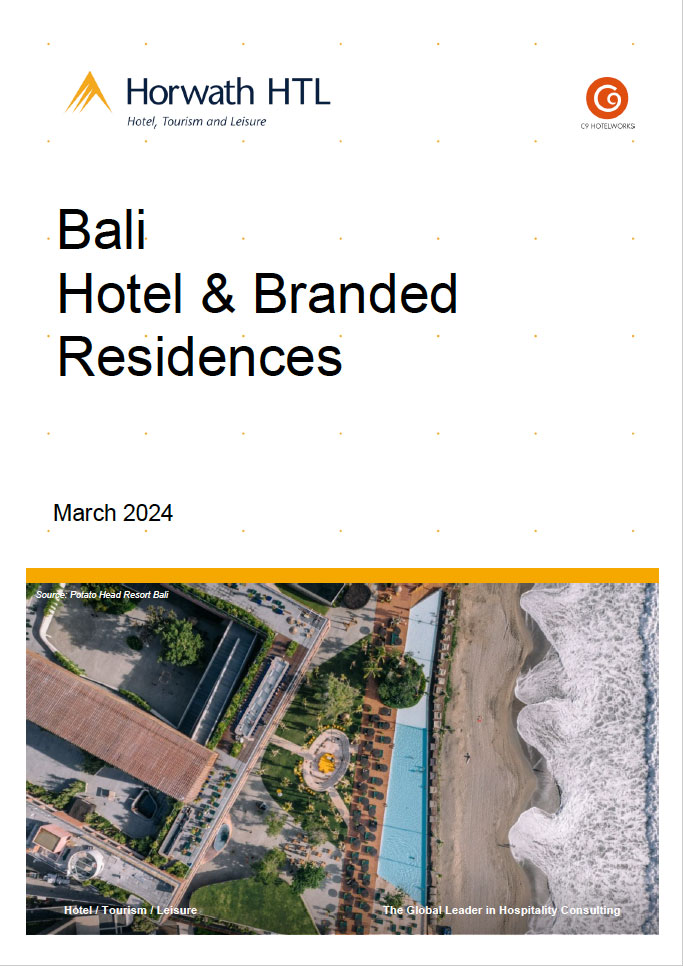
Market Report
Bali Hotels & Branded Residences 2024
In 2023, Bali’s hotel market experienced a remarkable rebound, surpassing peak 2019 RevPAR numbers by a whopping 37% (entirely ADR driven).
The only performance matrix sliding is ALOS down to just over 3 days, no doubt impacted by ADR increases – in it for a good time, not a long time.
By rate category, luxury resorts’ ADR soared and the upper-midscale resorts nailed RevPAR. Outstanding occupancy in both Kuta and Legian (Sanur boomed) and rates at resorts in Jimbaran / Uluwatu surpassed expectations.
Bali’s branded residences sector is on an upward trajectory this year, bolstered by strong demand for second homes and investment into leisure-oriented real estate.
Visitor Trends
The international visitor counts of 5.3 million by the end of 2023 marked a recovery from pandemic lows but remained below pre-pandemic figures. The nationality mixes of visitors shifted, with fewer Chinese tourists and increased numbers from Australia, South Korea, Singapore, and India, reflecting the Indonesian government’s strategic foreign relations.
Regional Source Markets
Australia remained the top foreign source market, contributing 25% of total foreign arrivals, followed by India and China. The ASEAN region and Europe saw slight increases, while the Americas and Africa maintained steady figures. This diversification underscores Bali’s resilience and broad appeal.
Overall Market Metrics
Bali’s overall hotel market performance in 2023 saw a 30% increase in both Average Daily Rate (ADR) and Revenue per Available Room (RevPAR) compared to 2019. Occupancy rates improved significantly, reaching 72%, reflecting the pent-up demand and increased airlift at reduced prices.
Segment Performance
- Luxury Segment: Occupancy reached 55%, with ADR and RevPAR showing strong growth.
- Upper-Upscale Segment: Notable improvements with occupancy at 73%, ADR up 17%, and RevPAR up 42%.
- Upscale Segment: Occupancy at 74%, ADR increased by 19%, and RevPAR by 68%.
- Upper-Midscale Segment: Strong recovery with occupancy at 78%, ADR up by 26%, and RevPAR by 82%.
- Midscale Segment: Highest RevPAR growth among all segments, indicating robust recovery.
- Economy Segment: Occupancy and ADR both increased, showing a strong market for budget accommodations.
Location-Specific Performance
Different regions in Bali showed varying levels of recovery, with Kuta and Legian maintaining high occupancy levels. Sanur exhibited the highest growth in occupancy, driven by increased congestion in other areas and the rising trend for quieter vacation spots.
Average Length of Stay (ALOS)
In 2023, the ALOS was just over three days, slightly down from 2019. The ADR increase likely shortened visitors’ lengths of stay. Seminyak had the longest ALOS, while Tanjung Benoa and Legian saw significant declines.
Market Outlook
Bali’s hotel market is expected to continue its positive trajectory, with anticipated consolidations in the Luxury and Upper-Upscale segments. The mid-range segments are likely to focus on pushing rates, particularly with the return of the Chinese market.
New Supply
A pipeline of 3,253 rooms across 23 new hotels is scheduled to open between 2024 and 2027. The majority of new developments are in the Upscale and Luxury segments, with significant growth anticipated in Jimbaran/Uluwatu and Canggu.
Branded Residences
Bali has seen limited penetration of branded residences compared to other Southeast Asian destinations. However, there is a growing interest from developers, and new projects are expected to launch within the next 12-24 months. Factors driving this interest include global migration trends, remote work practices, and lifestyle changes post-pandemic.
Download the report
For detailed charts, graphs, and further analysis, download the full report here




